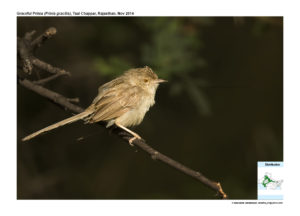Graceful Prinia

Graceful Prinia Prinia gracilis
Etymology :
- Prinia : Javanese name Prinya for the Prinia
- Gracilis: Latin word for slender, thin
Vernacular Names : Baluchistan: Pitak, Hindi: Khar phutki, Sind: Door, Guj: Vid fudki, Ran fadakfutki
Distribution in India: Resident across state of Gujarat and foothills of North India.
Description: Size of 15-16 cm. They have indistinct creamy Supercilium above grey lores and creamy eyering; cheek and ear-coverts grey; crown and upperparts pale sandy brown, dark brown central streaks on feathers of crown, mantle and scapulars, almost unstreaked (only slightly darker shafts) on back, rump and uppertail-coverts; wing feathers dark brown with buffy-brown margins; tail brown, faintly barred darker above, with distinct blackish sub-terminal band and whitish tip on underside (central feather pair lacks white tip); throat and underparts whitish, faint buff wash on flanks, thighs and undertail-coverts; iris yellowish-brown; bill and mouth black in breeding season (male, also female in some areas), bill horn-brown in non-breeding season; legs pink or flesh-brown.
Habitat : It is found in fairly arid areas, including shrubs and small trees, herbs , reed beds, riparian scrub and dry riverbeds.
Food Habits: It eats small invertebrates, chiefly insects and their larvae, and small spiders, also eats flower nectar. Usually singly or in pairs. Although not shy, is generally unobtrusive, keeping low in vegetation. Forages close to ground, climbing up stalks or inside bushes, gleaning insects from both leaves and ground.
Breeding Habits:They breed in Feb–Oct. The nest is constructed mainly by male, female assists with lining; an oval structure with side entrance near top, made of dry grass and other plant material spider cocoons and spider web, placed above ground in fairly tall grass, palm or tree with nest of other bird, including Cisticola juncidis and Purple Sunbird, occasionally used; new nest built for each breeding attempt, male sometimes using material from an old nest. They lay a clutch of 3–5 eggs . Incubation done by both sexes , from penultimate egg. incubation period is 11–13 days; adults continue to add lining to nest after start of incubation; hatching synchronous, or last egg 1 day after others, chicks brooded mainly (occasionally solely) by female, fed by both sexes, nestling period 12–14 days